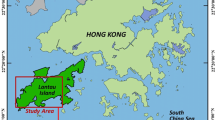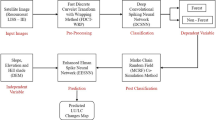Abstract
Inherent limitations of Landsat images restrict the accuracy of land categorization efforts for a better comprehension involved in transforming raw image data into relevant land cover information. Managing mixed pixels and complex spectrum responses, the introduction of advanced algorithmic approaches is essential. Hybrid classification methods that include spectral, spatial, and contextual data can increase the precision of assigning class labels to pixels with confusing features. This paper demonstrate the construction of automatic images segmentation based on deep convolution neural networks with object-oriented integration. Harnessing machine learning approaches in remote sensing images, an exper imental phase showed the best fit model that can be implemented further into larger areas with a Kappa validation value of 99.466% and errors of 0.015 on average. The model used to classify land use to see land degrada tion in Air Bengkulu watershed, the main source of annual flood disaster in Bengkulu area. We found that the area has been reduced by 20%, 1.9%, 48%, and 7.9% for forest, bare land, plantations, and rice fields, respectively, from its initial area of year 2000. Furthermore, increase value of palm oil plantations (7.6%) over the area showed indirectly reason for replacement of agriculture allocation with correlation value of 97.12%.




Similar content being viewed by others
References
Webber, J. L., Gibson, M. J., Chen, A. S., Savic, D., Fu, G., & Butler, D. (2018). Rapid assessment of surface-water flood-management options in urban catchments. Urban Water Journal, 15, 210–217. https://doi.org/10.1080/1573062X.2018.1424212
Wingfield, T., Macdonald, N., Peters, K., Spees, J., & Potter, K. (2019). Natural flood management: Beyond the evidence debate. Area, 51(4), 743–751. https://doi.org/10.1111/area.12535
Sulistyo, B., Suhartoyo, H., Adiprasetyo, T., & Hindarto, K. S. (2021). Noviyanti: Accuracy of the level of critical water catchment area for flood mitigation around Bengkulu city Indonesia. Indonesian Journal of Geography, 53, 226–235.
Gunawan, G. (2021). Flood modelling of air Bengkulu watershed. Indonesia, using SUH and HEC-HMS. IOP Conference Series: Earth and Environmental Science, 871, 1–7.
Mase, L. Z. (2020). Slope stability and erosion-sedimentation analyses along sub-watershed of Muara Bangkahulu River in Bengkulu City, Indonesia. In E3S Web of Conferences (Vol. 148). https://doi.org/10.1051/e3sconf/202014803002
BNPB. Infografis Bencana Banjir Dan Longsor Bengkulu. https://bnpb.go.id/infografis/infografis-bencana-banjir-dan-longsor-bengkulu
Parinduri, R.T., Gunawan, G., & Amri, K. (2019). Evaluasi kinerja das air bengkulu dengan menggunakan metode hss nakayasu dan program hec ras versi 5.0.1 (studi kasus das air bengkulu). In Civil engineering and built environment conference 2019.
Rassarandi, F. D., & Tambunan, B. R. S. (2019). Penerapan fuzzy logic Dalam Pembuatan Peta element at risk Bencana Luapan Banjir Sangai air Bengkulu Kota Bengkulu. Jurnal Integrasi, 11(2), 135–139.
Finkbeiner, M. (2014). Indirect land use change - Help beyond the hype? Biomass and Bioenergy, 62, 218–221. https://doi.org/10.1016/j.biombioe.2014.01.024
Brinkman, M. L. J., van der Hilst, F., Faaij, A. P. C., & Wicke, B. (2021). Low-ILUC- risk rapeseed biodiesel: potential and indirect ghg emission effects in eastern Romania. Biofuels. https://doi.org/10.1080/17597269.2018.1464873
Srisunthon, P., & Chawchai, S. (2020). Land-use changes and the effects of oil palm expansion on a peatland in southern Thailand. Frontiers in Earth Science, 8, 559868. https://doi.org/10.3389/feart.2020.559868
Azhar, B., Nobilly, F., Lechner, A. M., Tohiran, K. A., Maxwell, T. M. R., Zulkifli, R., Kamel, M. F., & Oon, A. (2021). Mitigating the risks of indirect land use change (ILUC) related deforestation from industrial palm oil expansion by sharing land access with displaced crop and cattle farmers. Land Use Policy, 107, 105498. https://doi.org/10.1016/j.landusepol.2021.105498
Wicke, B., Sikkema, R., Dornburg, V., & Faaij, A. (2011). Exploring land use changes and the role of palm oil production in Indonesia and Malaysia. Land Use Policy, 28, 193–206. https://doi.org/10.1016/j.landusepol.2010.06.001
Zhou, D. X. (2020). Universality of deep convolutional neural networks. Applied and Computational Harmonic Analysis, 48, 787–794.
Sun, J., He, W.-T., Wang, L., Lai, A., Ji, X., Zhai, X., Li, G., Suchard, M. A., Tian, J., Zhou, J., Veit, M., & Su, S. (2020). Covid-19: Epidemiology, evolution, and cross-disciplinary perspectives. Trends in Molecular Medicine. https://doi.org/10.1016/J.MOLMED.2020.02.008
Khan, A., Sohail, A., Zahoora, U., & Qureshi, A. S. (2020). A survey of the recent architectures of deep convolutional neural networks. Artificial intelligence review, 53, 5455–5516.
Hansen, S. B., Padfield, R., Syayuti, K., Evers, S., Zakariah, Z., & Mastura, S. (2015). Trends in global palm oil sustainability research. Journal of Cleaner Production, 100, 140–149. https://doi.org/10.1016/j.jclepro.2015.03.051
Taheripour, F., & Tyner, W. E. (2020). Us biofuel production and policy: Implications for land use changes in Malaysia and Indonesia. Biotechnology for Biofuels, 13(1), 1–17. https://doi.org/10.1186/s13068-020-1650-1
Seydi, S. T., Hasanlou, M., & Amani, M. (2020). A new end-to-end multi- dimensional CNN framework for land cover/land use change detection in multi-source remote sensing datasets. Remote Sensing, 12, 2010.
Zhang, Y., et al. (2021). An integrated CNN model for reconstructing and predicting land use/cover change: A case study of the Baicheng area northeast china. Remote Sensing, 13, 4846.
Amini, S., Saber, M., Rabiei-Dastjerdi, H., & Homayouni, S. (2022). Urban land use and land cover change analysis using random forest classification of landsat time series. Remote Sensing, 14, 1–23.
Chaudhury, A., Ward, C., Talasaz, A., Ivanov, A. G., Brophy, M., Grodzin-ski, B., Huner, N. P. A., Patel, R. V., & Barron, J. L. (2019). Machine vision system for 3d plant phenotyping. IEEE/ACM Transactions on Computational Biology and Bioinformatics, 16, 2009–2022.
Kolagati, S., Priyadharshini, T., & Rajam, V. M. A. (2022). Exposing deepfakes using a deep multilayer perceptron—convolutional neural network model. International Journal of Information Management Data Insights, 2, 100054. https://doi.org/10.1016/j.jjimei.2021.100054
Nazarova, T., Martin, P., & Giuliani, G. (2020). Monitoring vegetation change in the presence of high cloud cover with sentinel-2 in a lowland tropical forest region in brazil. Remote Sensing, 12, 1829. https://doi.org/10.3390/rs12111829
Lang, L., Xu, K., Zhang, Q., & Wang, D. (2021). Fast and accurate object detection in remote sensing images based on lightweight deep neural network. Sensors, 21, 5460. https://doi.org/10.3390/s21165460
Jin, L., & Liu, G. (2021). An approach on image processing of deep learning based on improved ssd. Symmetry, 13, 495. https://doi.org/10.3390/sym13030495
Deng, Z., Sun, H., Zhou, S., Zhao, J., Lei, L., & Zou, H. (2018). Multi-scale object detection in remote sensing imagery with convolutional neural networks. ISPRS Journal of Photogrammetry and Remote Sensing, 145, 3–22.
Tu, F., Yin, S., Ouyang, P., Tang, S., Liu, L., & Wei, S. (2017). Deep convolutional neural network architecture with reconfigurable computation patterns. IEEE Transactions on Very Large Scale Integration (VLSI) Systems, 25, 2220–2233.
Fernandes, F. E., & Yen, G. G. (2021). Pruning deep convolutional neural networks architectures with evolution strategy. Information Sciences, 552, 29–47. https://doi.org/10.1016/j.ins.2020.11.009
Redmon, J., & Farhadi, A. (2017). Yolo v2.0. Cvpr2017.
Bhosle, K., & Musande, V. (2019). Evaluation of deep learning cnn model for land use land cover classification and crop identification using hyperspectral remote sensing images. Journal of the Indian Society of Remote Sensing, 47, 1949–1958.
Fauvel, M., Chanussot, J., & Benediktsson, J. A. (2012). A spatial-spectral kernel- based approach for the classification of remote-sensing images. Pattern Recognition, 45, 381–392. https://doi.org/10.1016/j.patcog.2011.03.035
Decuyper, M., Chavez, R. O., Lohbeck, M., Lastra, J. A., Tsendbazar, N., Hacklander, J., Herold, M., & Vagen, T. G. (2022). Continuous monitoring of forest change dynamics with satellite time series. Remote Sensing of Environment, 269, 112829. https://doi.org/10.1016/j.rse.2021.112829
Ayele, W. Y. (2020). Adapting crisp-dm for idea mining. International Journal of Advanced Computer Science and Applications, 11, 20–32.
Su, G. (2019). Analysis of optimisation method for online education data mining based on big data assessment technology. International Journal of Continuing Engineering Education and Life-Long Learning, 29, 321–335. https://doi.org/10.1504/IJCEELL.2019.102768
Xiong, Y., Guo, S., Chen, J., Deng, X., Sun, L., Zheng, X., & Xu, W. (2020). Improved srgan for remote sensing image super-resolution across locations and sensors. Remote Sensing, 12, 1263. https://doi.org/10.3390/RS12081263
Qin, M., Mavromatis, S., Hu, L., Zhang, F., Liu, R., Sequeira, J., & Du, Z. (2020). Remote sensing single-image resolution improvement using a deep gradient-aware network with image-specific enhancement. Remote Sensing, 12, 758. https://doi.org/10.3390/rs12050758
Heydarian, M., Doyle, T. E., & Samavi, R. (2022). Mlcm: Multi-label confusion matrix. IEEE Access, 10, 19083–19095. https://doi.org/10.1109/ACCESS.2022.3151048
Xu, J., Zhang, Y., & Miao, D. (2020). Three-way confusion matrix for classification: A measure driven view. Information Sciences, 507, 772–794. https://doi.org/10.1016/j.ins.2019.06.064
Sun, Z., Qi, M., Lian, J., Jia, W., Zou, W., He, Y., Liu, H., & Zheng, Y. (2018). Image segmentation by searching for image feature density peaks. Applied Sciences (Switzerland), 8, 969. https://doi.org/10.3390/app8060969
Chen, Y., Fan, R., Bilal, M., Yang, X., Wang, J., & Li, W. (2018). Multilevel cloud detection for high-resolution remote sensing imagery using multiple convo lutional neural networks. ISPRS International Journal of Geo-Information, 7, 181. https://doi.org/10.3390/ijgi7050181
Xiao, P., Zhang, X., Wang, D., Yuan, M., Feng, X., & Kelly, M. (2016). Change detection of built-up land: A framework of combining pixel-based detection and object-based recognition. ISPRS Journal of Photogrammetry and Remote Sensing, 119, 402–414. https://doi.org/10.1016/j.isprsjprs.2016.07.003
Pedersen, E. J., Miller, D. L., Simpson, G. L., & Ross, N. (2019). Hierarchical generalized additive models in ecology: An introduction with mgcv. PeerJ, 7, e6876. https://doi.org/10.7717/peerj.6876
Wood, S. N. (2020). Mixed gam computation vehicle with automatic smoothness estimation. Generalized Additive Models: An Introduction with R. 2nd Edition, (pp. 1.8–33).
Miculescu, R., Mihail, A., & Urziceanu, S. A. (2020). A new algorithm that generates the image of the attractor of a generalized iterated func tion system. Numerical Algorithms, 83, 1399–1413. https://doi.org/10.1007/s11075-019-00730-w
Ilahude, D. (2010). Heavy metal contents in marine sediments and seawater at Totok bay area, North Sulawesi. Bulletin of the Marine Geology, 25(1), 39–52. https://doi.org/10.32693/bomg.25.1.2010.24
Khalik, I., Sapei, A., Hariyadi, S., & Anggraeni, E. (2022). The water quality characteristics and quality status of Bengkulu river and Nelas river, Bengkulu province: Conditions for the last six years. (vol. 950). https://doi.org/10.1088/1755-1315/950/1/012038
WanMohdJaafar, W. S., Said, N. F. S., Abdul Maulud, K. N., Uning, R., Latif, M. T., Muhmad Kamarulzaman, A. M., Mohan, M., Pradhan, B., Saad, S. N. M., Broadbent, E. N., Cardil, A., Silva, C. A., & Takriff, M. S. (2020). Carbon emissions from oil palm induced forest and peatland conversion in Sabah and Sarawak Malaysia. Forests, 11(12), 1285.
Pambudi, A. S. (2020). The development of social forestry in Indonesia. The Journal of Indonesia Sustainable Development Planning, 1(1), 57–66. https://doi.org/10.46456/jisdep.v1i1.11
Runtuboi, Y. Y., Permadi, D. B., Sahide, M. A. K., & Maryudi, A. (2021). Oil palm plantations, forest conservation and indigenous peoples in west Papua province: What lies ahead? Forest and Society, 5, 2. https://doi.org/10.24259/fs.v5i1.11343
Acknowledgements
This study is supported by the funding from The Ministry of Education, Culture, Research, and Technology under the contract number 211/E5/PG.02.00.PT/2022, 30 May 2022 and 1946/UN30.15/PP/2022, 16 June 2022 by the Research and Community Service of University of Bengkulu.
Author information
Authors and Affiliations
Corresponding author
Additional information
Publisher's Note
Springer Nature remains neutral with regard to jurisdictional claims in published maps and institutional affiliations.
Rights and permissions
Springer Nature or its licensor (e.g. a society or other partner) holds exclusive rights to this article under a publishing agreement with the author(s) or other rightsholder(s); author self-archiving of the accepted manuscript version of this article is solely governed by the terms of such publishing agreement and applicable law.
About this article
Cite this article
Vatresia, A., Utama, F., Sugianto, N. et al. Automatic image segmentation model for indirect land use change with deep convolutional neural network. Spat. Inf. Res. 32, 327–337 (2024). https://doi.org/10.1007/s41324-023-00560-y
Received:
Revised:
Accepted:
Published:
Issue Date:
DOI: https://doi.org/10.1007/s41324-023-00560-y




